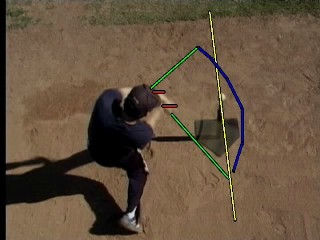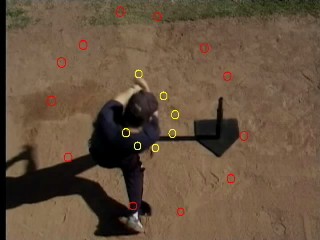
 | |
 | |
|
CHP w/ New Video Clip Posted by: Jack Mankin (MrBatspeed@aol.com) on Tue Feb 20 23:05:00 2007 >>> Jack,
The knob does point toward the incoming pitch as rotation brings the hands around. There is a linear component to the swing. As rotation start to bring the bat around and the hands are coming forward, the bat is pointing straight back for awhile. I don't think the side view is lying. It just gives you a different perspective. This can be seen in a view directly behind the hitter as well. The linear component is there in many swings. Try this clip, are you saying that there isn't a force directed down the length of the bat as well as the bat rotating? http://home.comcast.net/~bellshw/pujolsslomo.mov <<< -------------- Hi Shawn Sorry, I could not view the clip. With my computer, only the slide-bar appeared. The knob rotates through about 180 degrees of rotation from launch to contact. When the bat has rotated through about 90 degrees to the lag position, the knob would, at some point, be pointing toward the pitcher. However, neither the hands nor the knob stall their angular rate of acceleration at the lag position and slide linear toward the pitcher. The bat (knob & bat-head) continues their angular acceleration right through the lag position. When we were filming batters for the DVD, the cameraman suggested we set the shutter speed at 1/500 sec or higher to eliminate blurring and provide a clearer picture when played back frame-by-frame. I explained to him that if we filmed at higher shutter speeds, the bat would appear fixed, or stalled, in each frame. The blur offered at 1/60 sec shows the angular displacement of the bat that occurs during a 1/60-second period. This provides greater information for an analysis. -- When viewing a clip of a good hitter, if the bat appears stalled at the lag position, the clip was probably shot at a high shutter speed. Shawn, so that I better understand your position for the need of linear components in the swing, would you point out the “linear components” of either John’s hands or his bat in the clip below. (12mb-- need windows movie player).   Jack Mankin Followups:
Post a followup:
|
![]()